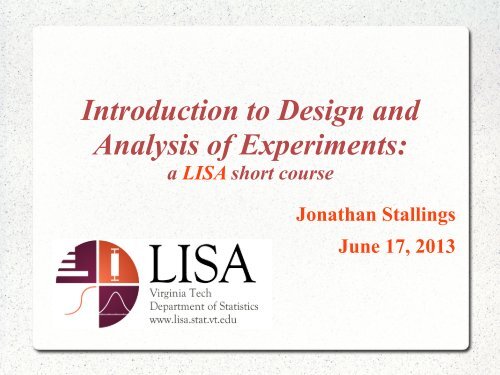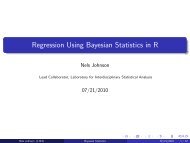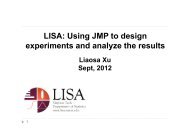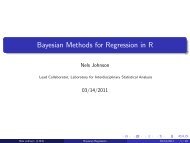Introduction to Design and Analysis of Experiments: - LISA
Introduction to Design and Analysis of Experiments: - LISA
Introduction to Design and Analysis of Experiments: - LISA
You also want an ePaper? Increase the reach of your titles
YUMPU automatically turns print PDFs into web optimized ePapers that Google loves.
<strong>Introduction</strong> <strong>to</strong> <strong>Design</strong> <strong>and</strong><br />
<strong>Analysis</strong> <strong>of</strong> <strong>Experiments</strong>:<br />
a <strong>LISA</strong> short course<br />
Jonathan Stallings<br />
June 17, 2013
My Qualifications<br />
<br />
<br />
<br />
<br />
4 th Year PhD Statistics Student<br />
BS in Mathematics, UMW<br />
MS in Statistics, VT<br />
Main research interest is Experimental <strong>Design</strong><br />
I help researchers answer their specific<br />
questions by giving them the best possible<br />
“<strong>to</strong>ols” <strong>to</strong> collect <strong>and</strong> analyze their data.
A little about <strong>LISA</strong><br />
<br />
<br />
Labora<strong>to</strong>ry for Interdisciplinary Statistical <strong>Analysis</strong><br />
Free Collaboration:<br />
– Experimental <strong>Design</strong> – Data <strong>Analysis</strong> – S<strong>of</strong>tware Help<br />
<br />
<br />
Interpreting Results – Grant Proposals<br />
Free Walk-In Consulting for quick statistics questions<br />
Free Short Courses<br />
– R tu<strong>to</strong>rial; Structural Equation Modeling; Plotting Data<br />
Improve research quality through<br />
project collaboration <strong>and</strong><br />
statistical consulting
Requesting a <strong>LISA</strong> Meeting<br />
<br />
<br />
<br />
<br />
<br />
To request a collaboration go <strong>to</strong>: www.lisa.stat.vt.edu<br />
Sign in using VT PID <strong>and</strong> password<br />
Enter your information (e-mail, college, etc.)<br />
Describe your project (project title, research goals,<br />
specific research questions, do you have data, etc.)<br />
Contact assigned <strong>LISA</strong> collabora<strong>to</strong>rs as soon as possible <strong>to</strong><br />
schedule meeting<br />
We prefer <strong>to</strong> meet with you before<br />
data collection!
Short Course Goals<br />
<br />
<br />
<br />
<br />
Discuss difference between designed experiment <strong>and</strong><br />
observational study<br />
Introduce terminology used by statisticians <strong>to</strong> make<br />
collaboration easier<br />
Detail fundamentals <strong>of</strong> a good design<br />
Explain how <strong>to</strong> analyze data in JMP <strong>to</strong> answer research<br />
questions (conclusions <strong>and</strong> interpretations)
What we won't be talking about<br />
<br />
<br />
<br />
<br />
<br />
<strong>Design</strong>ing Surveys<br />
Sample size calculations<br />
Assumption Checking<br />
Measurement Error<br />
Sequential <strong>Design</strong> (Response Surface methodology)<br />
These are important design questions, but some involve more<br />
advanced design techniques <strong>and</strong> statistical knowledge. <strong>LISA</strong><br />
collaboration meetings are ideal for these questions.
Sources <strong>of</strong> Variation
Sources <strong>of</strong> Variation: Example<br />
<br />
<br />
Flip a quarter: Heads<br />
Flip a nickel: Tails<br />
Wikipedia.org<br />
Marshu.com<br />
<br />
Why did we get two different responses?<br />
We may argue that if we identify all aspects that went in<strong>to</strong> a<br />
given coin <strong>to</strong>ss <strong>and</strong> can perfectly replicate it, we will get the<br />
exact same result.
Sources <strong>of</strong> Variation<br />
<br />
<br />
A source <strong>of</strong> variation is anything that could cause an<br />
observation <strong>to</strong> be different from another observation<br />
Characteristics<br />
– Degree <strong>of</strong> variability<br />
– Consistency <strong>of</strong> effect<br />
– Can it be controlled?<br />
<br />
The goal is <strong>to</strong> identify few sources <strong>of</strong> variation that<br />
explain the majority <strong>of</strong> the variability.
Explaining Variance VS<br />
Sources <strong>of</strong> Variation<br />
<br />
Large cities have recorded simultaneous increases in<br />
monthly murder rates <strong>and</strong> ice cream sales.<br />
Credit: Taylor Dewey, using public images<br />
<br />
In this case, ice cream sales help “explain variance”<br />
<strong>of</strong> murder rates, but aren't a source <strong>of</strong> variation
Two types <strong>of</strong> Major Sources <strong>of</strong><br />
Variation<br />
<br />
Those that can be controlled <strong>and</strong> are <strong>of</strong> interest are<br />
called treatments or treatment fac<strong>to</strong>rs<br />
• Drug in medical experiment<br />
• Settings on machine producing tires<br />
• Different types <strong>of</strong> political advertising <strong>to</strong> encourage voting<br />
<br />
Those that are not <strong>of</strong> interest but are difficult <strong>to</strong> control<br />
are nuisance fac<strong>to</strong>rs<br />
• Sex<br />
• Age<br />
• Weather
Dealing with Sources <strong>of</strong> Variation<br />
<br />
<br />
<br />
<br />
The primary goal <strong>of</strong> an experiment is <strong>to</strong> determine the<br />
amount <strong>of</strong> variation caused by the treatment fac<strong>to</strong>rs in<br />
the presence <strong>of</strong> other sources <strong>of</strong> variation.<br />
Want the majority <strong>of</strong> the variability <strong>of</strong> the data <strong>to</strong> come<br />
from the treatment fac<strong>to</strong>rs<br />
A good design will minimize the impact <strong>of</strong> minor<br />
sources <strong>of</strong> variation, while taking in<strong>to</strong> account<br />
variability caused by nuisance fac<strong>to</strong>rs<br />
Let's go back <strong>to</strong> the coin example...
Sources <strong>of</strong> Variation: Example<br />
<br />
<br />
<br />
<br />
Response: Probability <strong>of</strong> flipping heads<br />
Potential treatment fac<strong>to</strong>rs:<br />
• Type <strong>of</strong> coin<br />
• Heads/Tails up before flip<br />
Nuisance fac<strong>to</strong>rs:<br />
• Person flipping coin<br />
Minor sources <strong>of</strong> variability:<br />
• Environmental fac<strong>to</strong>rs (e.g. wind)
Sources <strong>of</strong> Variation: Summary<br />
<br />
<br />
<br />
<br />
<br />
A source <strong>of</strong> variation is anything that causes an<br />
observation <strong>to</strong> be different from another observation<br />
List potential major <strong>and</strong> minor sources <strong>of</strong> variation<br />
before collecting data<br />
A treatment fac<strong>to</strong>r can be controlled<br />
Minimize the impact <strong>of</strong> minor sources <strong>of</strong> variation, <strong>and</strong><br />
be able <strong>to</strong> separate effects <strong>of</strong> nuisance fac<strong>to</strong>rs from<br />
treatment fac<strong>to</strong>rs<br />
We want the majority <strong>of</strong> the variability <strong>of</strong> the data<br />
<strong>to</strong> be explained by the treatment fac<strong>to</strong>rs
Observational Study<br />
vs<br />
<strong>Design</strong>ed Experiment
Observational Studies VS<br />
<strong>Design</strong>ed Experiment<br />
http://xkcd.com/552/
Your conclusions are only as good as<br />
your data
Observational Studies<br />
<br />
<br />
<br />
When the researcher has little/no control over sources<br />
<strong>of</strong> variation <strong>and</strong> simply observes what's happening<br />
Examples:<br />
– Surveys<br />
– Investigating effects <strong>of</strong> cancer on human subjects<br />
– Weather patterns, s<strong>to</strong>ck market price, etc.<br />
These types <strong>of</strong> studies relate <strong>to</strong> the statement:<br />
Correlation does not imply causation
<strong>Design</strong>ed Experiment<br />
<br />
<br />
<br />
The researcher identifies <strong>and</strong> controls sources <strong>of</strong><br />
variation that significantly impact the measured<br />
response<br />
Examples:<br />
– Assign different medications <strong>to</strong> subjects with a similar<br />
illness<br />
– Assign different credit card limit rates <strong>to</strong> cus<strong>to</strong>mers<br />
with a similar financial situation<br />
– Assign different amounts <strong>of</strong> carcinogen <strong>to</strong> lab rats<br />
Differences between observations primarily result<br />
from treatment fac<strong>to</strong>rs (evidence <strong>of</strong> causation)
Example 1: Obs Study or <strong>Design</strong>?<br />
<br />
<br />
<br />
Differences in milk butter fat for cows<br />
Potential sources <strong>of</strong> variation:<br />
– Three age groups (A1, A2, A3)<br />
– Four breeds (B1, B2, B3, B4)<br />
R<strong>and</strong>omly select two cows from each age/breed<br />
B1 B2 B3 B4<br />
A1<br />
A2<br />
A3
Example 2: Obs Study or <strong>Design</strong>?<br />
<br />
<br />
<br />
Develop a treatment <strong>to</strong> increase milk butter fat<br />
Potential sources <strong>of</strong> variation:<br />
– Age <strong>and</strong> Breed<br />
– Treatment (Yes or No)<br />
R<strong>and</strong>omly assign treatment <strong>to</strong> one <strong>of</strong> the two cows from<br />
each age/breed<br />
B1 B2 B3 B4<br />
A1 Y/N N/Y ...<br />
A2<br />
A3
Obs Study VS <strong>Design</strong>: Summary<br />
<br />
<br />
<br />
<br />
Observational studies have minimal intervention by the<br />
researcher, weakening conclusions about causation<br />
With designed experiments, the researcher has much more<br />
control <strong>and</strong> does everything possible <strong>to</strong> make variability<br />
due <strong>to</strong> treatment fac<strong>to</strong>rs alone<br />
Researchers <strong>of</strong>ten use observational studies <strong>to</strong> generate<br />
hypotheses <strong>and</strong> test them using designed experiments<br />
Data collected from both scenarios are analyzed the<br />
same way, but the conclusions are different.
Example <strong>of</strong> <strong>Design</strong>ed Experiment
<strong>Design</strong> Example<br />
<br />
<br />
<br />
Your child comes home from school <strong>and</strong> shows you what they<br />
learned in class.<br />
He/she asks for a film canister <strong>and</strong> an Alka-Seltzer tablet. They<br />
fill the canister with a little water, put the tablet in the water,<br />
close the canister <strong>and</strong> turn it upside down.<br />
After a few seconds, the canister flies in the air! Your child<br />
wants <strong>to</strong> know how <strong>to</strong> make the canister fly as high as possible.<br />
= BOOM!<br />
http://www.bbc.co.uk/leicester Water drop | S<strong>to</strong>ck Vec<strong>to</strong>r ©<br />
Natalja Jatsuk #2449987<br />
http://www.aqualuxcarpetcleaning.com<br />
http://www.youtube.com/watch?v=Gtbane7BBdQ&feature=related
<strong>Design</strong> Example<br />
<br />
<br />
Question: Does the amount <strong>of</strong> alka-seltzer affect flight<br />
time? Which amount gives the longest time?<br />
Three different amounts <strong>of</strong> alka-seltzer<br />
https://healthy.kaiserpermanente.org<br />
1/2 Tablet 1 Tablet 1.5 Tablets<br />
<br />
Response: Time from lif<strong>to</strong>ff <strong>to</strong> l<strong>and</strong>ing in seconds
<strong>Design</strong> Example<br />
<br />
<br />
<br />
What are some sources <strong>of</strong> variation?<br />
– Amount <strong>of</strong> alka-seltzer (Treatment Fac<strong>to</strong>r)<br />
– Amount <strong>of</strong> water<br />
– Film canister seal<br />
– Time Measurement<br />
– Angle <strong>of</strong> lif<strong>to</strong>ff<br />
Note: We could control amount <strong>of</strong> water, but are more<br />
interested in the amount <strong>of</strong> alka-seltzer<br />
Focus on the major sources <strong>of</strong> variation!
<strong>Design</strong> Example: Summary<br />
<br />
<br />
We need <strong>to</strong> reduce the impact <strong>of</strong> significant sources<br />
<strong>of</strong> variation other than the alka-seltzer amount.<br />
• Let's keep the amount <strong>of</strong> water constant, say 1/2 full<br />
• Perform experiment inside <strong>to</strong> reduce environment impact<br />
How do we actually perform the experiment?<br />
• How many times do we need <strong>to</strong> shoot the canister?<br />
• What order do we test the tablet amount? Does it matter?<br />
• Should we use different types <strong>of</strong> film canisters?<br />
• How are we going <strong>to</strong> measure time?
Fundamentals <strong>of</strong> <strong>Design</strong>
Experimental Units <strong>and</strong> Blocks<br />
<br />
<br />
<br />
<br />
An experimental unit (EU) is the “material” <strong>to</strong> which<br />
treatment fac<strong>to</strong>rs are assigned<br />
– Emphasis on the researcher administering the treatment!<br />
– For the milk butter fat experiment, the cows are the EUs<br />
Usually we want EUs <strong>to</strong> be as similar as possible,<br />
but that isn't always realistic<br />
A block is a group <strong>of</strong> EUs more similar than other EUs<br />
A blocking fac<strong>to</strong>r is the characteristic used <strong>to</strong> create<br />
the blocks.
Three Fundamental Principles<br />
<br />
<br />
A design is the proposed allocation <strong>of</strong> treatments <strong>to</strong><br />
EUs<br />
Three fundamental concepts <strong>to</strong> any design:<br />
– Replication <strong>of</strong> treatment<br />
– R<strong>and</strong>omization <strong>of</strong> treatment assignment<br />
– Local error control<br />
• <strong>Analysis</strong> <strong>of</strong> Covariance (ANCOVA)<br />
<br />
• Blocking <strong>of</strong> EU's<br />
Neglecting <strong>to</strong> acknowledge these will result in<br />
potential bias <strong>and</strong> skepticism
Film Canister Experiment<br />
Sxc.hu<br />
<br />
<br />
<br />
Treatments: Three different amounts <strong>of</strong> Alka-Seltzer<br />
EUs: Assume we have 9 nearly identical film<br />
canisters.<br />
How do we use the fundamental principles <strong>to</strong> compare<br />
these two designs?<br />
Run Order 1 2 3 4 5 6 7 8 9<br />
<strong>Design</strong> 1 1 1 1 1 0.5 0.5 0.5 1.5 1.5<br />
<strong>Design</strong> 2 1.5 0.5 1.5 1.5 1 1 1 0.5 0.5<br />
Each box is an<br />
EU
Replication<br />
<br />
<br />
<br />
<br />
<br />
Replicating a treatment means assigning that treatment<br />
<strong>to</strong> multiple EU's<br />
Increasing replication → Decrease in variance<br />
If equal interest in estimating the treatments, try <strong>to</strong><br />
equally replicate the number <strong>of</strong> treatment<br />
assignments<br />
Related question: How many times <strong>to</strong> replicate?<br />
FC Example: There are three treatments (tablet size) <strong>and</strong><br />
say we use 9 canisters. So 9/3=3 reps
Replication<br />
Run Order 1 2 3 4 5 6 7 8 9<br />
<strong>Design</strong> 1 1 1 1 1 0.5 0.5 0.5 1.5 1.5<br />
<strong>Design</strong> 2 1.5 0.5 1.5 1.5 1 1 1 0.5 0.5<br />
<strong>Design</strong> 2 replicates each tablet size three times.<br />
<strong>Design</strong> 1 replicates one table four times, so it will<br />
estimate effect <strong>of</strong> one tablet better than the other<br />
tablet sizes.
R<strong>and</strong>omization<br />
<br />
<br />
<br />
<br />
R<strong>and</strong>omly assign which EU gets a treatment<br />
Reduces possibility <strong>of</strong> most types <strong>of</strong> bias caused by<br />
minor <strong>and</strong> undetectable sources <strong>of</strong> variation<br />
How we r<strong>and</strong>omize depends on the type <strong>of</strong> design<br />
FC Example: Some film canisters may have a small,<br />
indetectable hole, affecting the pressure necessary <strong>to</strong> launch<br />
the canister. R<strong>and</strong>omizing will give every treatment the same<br />
chance <strong>of</strong> being affected by this <strong>and</strong> will not be confounded<br />
with any treatment if we repeat the experiment many times.
R<strong>and</strong>omization<br />
Run Order 1 2 3 4 5 6 7 8 9<br />
<strong>Design</strong> 1 1 1 1 1 0.5 0.5 0.5 1.5 1.5<br />
<strong>Design</strong> 2 1.5 0.5 1.5 1.5 1 1 1 0.5 0.5<br />
It's possible <strong>to</strong> get both run orders by r<strong>and</strong>omization<br />
<strong>Design</strong> 1 has a clear pattern, while <strong>Design</strong> 2 “looks” more<br />
r<strong>and</strong>om<br />
As long as you used a proper r<strong>and</strong>omization device for<br />
both designs, use the r<strong>and</strong>omization given <strong>to</strong> you,<br />
even if it looks <strong>to</strong> have a pattern.
Local Error Control<br />
<br />
<br />
<br />
In general, this is any technique <strong>to</strong> improve accuracy <strong>and</strong><br />
precision <strong>of</strong> measuring treatment effects in the design<br />
Simple example: Have the same person take all<br />
measurements or operate machinery<br />
Techniques affecting analysis <strong>and</strong>/or design:<br />
– <strong>Analysis</strong> <strong>of</strong> Covariance (ANCOVA)<br />
– Blocking
Local Error Control: ANCOVA<br />
<br />
<br />
<br />
<br />
A covariate is a potential source <strong>of</strong> variation that we can't<br />
control but can measure during an experiment<br />
Differences in treatments can be difficult <strong>to</strong> detect if we<br />
don't take in<strong>to</strong> account covariate effect<br />
This does not change the design procedure<br />
Basic idea:<br />
– Estimate relationship <strong>of</strong> covariate <strong>and</strong> response<br />
– Compare treatments given this relationship
Local Error Control: ANCOVA<br />
<br />
<br />
Example: Suppose we did film canister experiment outside<br />
<strong>and</strong> there were unpredictable wind gusts<br />
How does neglecting this information affect comparisons <strong>of</strong><br />
alka-seltzer amount?
Local Error Control: Blocking<br />
<br />
<br />
<br />
<br />
Group EU's so that each block contains EU's that<br />
are more “homogeneous”<br />
Separate r<strong>and</strong>omizations for each block<br />
Just like with ANCOVA, we account for differences in<br />
block <strong>and</strong> then compare the treatments<br />
Example: Age/Breed combination was a blocking<br />
fac<strong>to</strong>r for the milk butter fat example when we wanted<br />
<strong>to</strong> compare treatments
Local Error Control: Blocking<br />
<br />
FC Example: Maybe we want <strong>to</strong> use three different<br />
types <strong>of</strong> film canisters which we feel may be<br />
significantly different from each other.<br />
Block<br />
Each box<br />
represents an EU<br />
with the block trait<br />
Bulletin.accurateshooter.com<br />
9 EU's in each<br />
block, call this<br />
“block size”<br />
Artnexus.com
<strong>Design</strong> Fundamentals: Summary<br />
<br />
<br />
<br />
<br />
<br />
<br />
An experimental unit is what we assign/apply<br />
treatments <strong>to</strong><br />
A block is a group <strong>of</strong> EUs more similar than other EUs<br />
Replication <strong>and</strong> r<strong>and</strong>omization increase precision <strong>and</strong><br />
reduce known/unknown sources <strong>of</strong> bias<br />
Accounting for covariate <strong>and</strong> block effects improves<br />
ability <strong>to</strong> detect treatment differences...<br />
...but we can't make causal inferences about them!<br />
Causal inference about treatment effects
What is a Replicate?
More on Replication<br />
<br />
<br />
<br />
An experimental unit is the material we assign/apply<br />
one treatment replicate <strong>to</strong><br />
Common question: How many replicates do I need?<br />
Need <strong>to</strong> consider:<br />
– Goals <strong>of</strong> experiment<br />
– $$$<br />
– Are treatments or EUs expensive?
Determining Sample Sizes<br />
<br />
<br />
<br />
<br />
There are many things we need <strong>to</strong> know or guess <strong>to</strong><br />
suggest sample sizes<br />
Variability<br />
– The more variability, the more replicates<br />
Minimal treatment difference <strong>to</strong> detect<br />
– The smaller the difference, the more replicates<br />
Collaboration meetings are ideal for these<br />
calculations
Subsampling: Pseudoreplication<br />
<br />
<br />
<br />
Naïve idea: Taking multiple measurements on the<br />
EU can be counted as a replication<br />
Variability in multiple measurements is measurement<br />
error not experimental error!<br />
The different measurements are called observational<br />
units (OUs)<br />
Approvedgasmasks.com Onyxinvesting.com S<strong>to</strong>pwatchsh.com
Consequences <strong>of</strong> Pseudoreplication<br />
<br />
<br />
<br />
Usually people average the measurements from the<br />
OUs <strong>and</strong> treat it as one observation<br />
What if we don't do this?<br />
– We severely underestime error<br />
– Overexaggerate true treatment differences<br />
What if measurement error is high?<br />
– Try <strong>to</strong> improve measurement process<br />
– Revisit experiment <strong>and</strong> assess homogeneity <strong>of</strong><br />
EUs <strong>and</strong> think <strong>of</strong> potential covariates
EU vs OU: Example<br />
<br />
<br />
Applying nitrogen concentration <strong>to</strong> compost<br />
What's the EU <strong>and</strong> what's the OU?<br />
Apply Nitrogen<br />
Break up<br />
in<strong>to</strong> three<br />
piles<br />
Take<br />
measurements<br />
on the three<br />
smaller piles<br />
Gardenpho<strong>to</strong>.com
Replication vs Subsample: Summary<br />
<br />
<br />
<br />
<br />
You can only replicate a treatment if you apply it <strong>to</strong> a<br />
new EU<br />
Determining sample sizes requires assumptions about<br />
variability<br />
Subsampling determines reliability <strong>of</strong> measurements<br />
Treating a subsample as a replicate increases the<br />
chance <strong>of</strong> incorrect conclusions
Completely R<strong>and</strong>omized <strong>Design</strong>
Completely R<strong>and</strong>omized <strong>Design</strong>s<br />
<br />
<br />
The simplest design assumes all the EU's are similar<br />
<strong>and</strong> the only major source <strong>of</strong> variation are the<br />
treatments<br />
A completely r<strong>and</strong>omized design (CRD) will<br />
r<strong>and</strong>omize all treatment-EU assignments for the<br />
specified number <strong>of</strong> treatment replications<br />
If equally interested in comparisons <strong>of</strong> all treatments<br />
get as close as possible <strong>to</strong> equally replicating the<br />
treatments
CRD Example: FC Experiment<br />
These are “similar” EU's<br />
The <strong>Design</strong> Plan:<br />
Before<br />
R<strong>and</strong>omization<br />
1/2 Tablet 1 Tablet 1 1/2 Tablet
CRD Example: FC Experiment<br />
The<br />
Implemented<br />
<strong>Design</strong>
<strong>Analysis</strong> <strong>of</strong> CRD: Plots<br />
<br />
<br />
<br />
Boxplots compare responses for different<br />
treatments<br />
Do the medians match up?<br />
Is the spread the same?
<strong>Analysis</strong> <strong>of</strong> CRD: ANOVA Table<br />
Overall ANOVA<br />
Effect Tests<br />
<br />
<br />
ANOVA partitions <strong>to</strong>tal variability in<strong>to</strong> separate,<br />
independent pieces:<br />
– MSTrt: Variability due <strong>to</strong> treatment differences<br />
– MSError: Variability due <strong>to</strong> experimental error<br />
If MSTrt > MSError then treatments likely have<br />
different effects!
<strong>Analysis</strong> <strong>of</strong> CRD: Contrasts<br />
Estimated mean<br />
difference 0.31<br />
with 95%<br />
confidence<br />
interval:<br />
(-1.6086, 2.22857)<br />
<br />
<br />
<br />
At least two treatments are different, which ones?<br />
Pairwise comparisons<br />
Use Tukey HSD for multiple pairwise comparisons
<strong>Analysis</strong> <strong>of</strong> CRD: Example<br />
<br />
<br />
<br />
<br />
<strong>Design</strong> implementation: Fill the canisters halfway with<br />
water for each run<br />
– Replicate each treatment 3 times<br />
Plot the data!<br />
ANOVA table for overall treatment differences<br />
Post-hoc tests: treatment comparisons (contrasts)
CRD & ANOVA: Summary<br />
<br />
<br />
<br />
<br />
<br />
<br />
CRD has one overall r<strong>and</strong>omization<br />
Try <strong>to</strong> equally replicate all the treatments<br />
Plot your data in a meaningful way <strong>to</strong> help visualize<br />
analysis<br />
Use ANOVA <strong>to</strong> test for an overall difference<br />
Look at specific contrasts <strong>of</strong> interest <strong>to</strong> better<br />
underst<strong>and</strong> relationship between treatments<br />
JMP <strong>and</strong> other s<strong>of</strong>tware are great <strong>to</strong>ols but be careful<br />
in reading <strong>and</strong> interpreting output
CRD Extended: Fac<strong>to</strong>rial Treatments
CRD Extension: Fac<strong>to</strong>rial Treatments<br />
<br />
<br />
<br />
<br />
Treatments could be combination <strong>of</strong> multiple fac<strong>to</strong>rs with<br />
different levels (think settings)<br />
We could do a separate experiment for each fac<strong>to</strong>r, but<br />
this is not necessary if we design carefully<br />
Example: For the FC experiment we may also vary water<br />
amount (low/medium/high). In this case one “treatment”<br />
is actually a combination <strong>of</strong> tablet <strong>and</strong> water amount<br />
The specific tablet <strong>and</strong> water amounts are referred <strong>to</strong><br />
as the levels <strong>of</strong> the tablet fac<strong>to</strong>r <strong>and</strong> water fac<strong>to</strong>r,<br />
respectively.
Fac<strong>to</strong>rial Example: FC Experiment<br />
1/2 tablet / Low water<br />
1 1/2 tablet / High Water
Fac<strong>to</strong>rial Example: FC Experiment
Interaction Plots<br />
Interaction!<br />
<br />
<br />
Plots <strong>of</strong> the treatment means<br />
Look at the behavior <strong>of</strong> the means as the levels vary
Fac<strong>to</strong>rial ANOVA: Cell Means<br />
This “cell mean” = mean <strong>of</strong><br />
all A1/W1 reps<br />
This is the<br />
average for<br />
all obs with<br />
W1<br />
<br />
<br />
<br />
A1<br />
A2<br />
A3<br />
W1 W2 W3<br />
2.06 1.74 0.47 1.42<br />
2.09 1.57 0.42 1.36<br />
2.02 1.55 0.39 1.32<br />
2.06 1.62 0.43<br />
Water levels<br />
Partition SSTrt in<strong>to</strong> main effects <strong>and</strong> interactions<br />
Average water levels different → Water main effect<br />
Differences between water levels changes depending on<br />
alka-seltzer amount → Water/Alka interaction
Fac<strong>to</strong>rial <strong>Analysis</strong>: Example<br />
<br />
<br />
Vary water <strong>and</strong> alka-seltzer amount (3 levels each)<br />
Only do 1 replicate each:<br />
– No degrees <strong>of</strong> freedom are left for MSE<br />
– First plot the effects using a half-normal QQ plot<br />
– Remove insignificant effects <strong>and</strong> then do ANOVA
Fac<strong>to</strong>rial <strong>Design</strong>: Summary<br />
<br />
<br />
<br />
<br />
<br />
Efficient way <strong>to</strong> test effect <strong>of</strong> multiple treatment<br />
fac<strong>to</strong>rs<br />
One treatment is combination <strong>of</strong> multiple fac<strong>to</strong>rs<br />
We may extend <strong>to</strong> more than two fac<strong>to</strong>rs, but the<br />
number <strong>of</strong> necessary EU's grows rapidly!<br />
Interaction plots help visualize effects<br />
Main effects <strong>and</strong> interactions are specific types <strong>of</strong><br />
important treatment comparisons
Complete Block <strong>Design</strong>
Blocking <strong>to</strong> Reduce Variance<br />
<br />
<br />
<br />
<br />
We think there is some source <strong>of</strong> variation that is an<br />
inherent trait <strong>of</strong> the EUs<br />
A block is a group <strong>of</strong> EUs more similar than the other<br />
EUs<br />
Basic Idea: Compare treatments within blocks <strong>to</strong><br />
account for source <strong>of</strong> variation<br />
If blocking has a significant effect, we can greatly<br />
reduce the variability <strong>of</strong> the treatment effects.
Blocking <strong>to</strong> Reduce Variance<br />
<strong>Design</strong> questions:<br />
– How many EUs per block?<br />
– How do we assign treatments <strong>to</strong> the EUs?<br />
– How do we r<strong>and</strong>omize?<br />
Block 1 Block 2 Block 3<br />
This is not a pretty<br />
design situation. What<br />
are some problems we<br />
may run in<strong>to</strong>?
Block Examples<br />
<br />
<br />
<br />
<br />
<br />
From FC example, we blocked by canister<br />
Male <strong>and</strong> Female<br />
Plots in a field (close <strong>to</strong>gether more similar)<br />
Note that in all <strong>of</strong> these cases, we cannot assign a<br />
block <strong>to</strong> an EU, it is an inherent property <strong>of</strong> the EU<br />
It's possible <strong>to</strong> create blocks (groups) from<br />
covariate information but we have <strong>to</strong> be able <strong>to</strong><br />
r<strong>and</strong>omize the treatments within the blocks!
Assigning treatment <strong>to</strong> blocks<br />
<br />
Remember, we want <strong>to</strong> “remove” block effects <strong>to</strong><br />
increase precision <strong>of</strong> treatment effects<br />
What's wrong with this design? Say we have 2<br />
treatments: T1 <strong>and</strong> T2<br />
Run Order 1 2 3 4 5 6 7 8 9<br />
Block 1 T1 T1 T1 T1 T1 T1 T1 T1 T1<br />
Block 2 T2 T2 T2 T2 T2 T2 T2 T2 T2<br />
<br />
Complete block design:<br />
# EUs per block = # treatments
Block <strong>Design</strong>: RCBD<br />
<br />
<br />
<br />
<br />
The block size is the number <strong>of</strong> EUs for the block<br />
If the block size equals the number <strong>of</strong> treatments we<br />
call this a r<strong>and</strong>omized complete block design.<br />
Think <strong>of</strong> this as separate CRD's for each block with<br />
one replicate. So when we r<strong>and</strong>omize we want <strong>to</strong>...<br />
RANDOMIZE TREATMENTS IN EACH BLOCK<br />
We can test if the block means are different, but<br />
cannot conclude differences were caused by the<br />
blocking fac<strong>to</strong>r.
RCBD <strong>Analysis</strong>: FC Example<br />
1 1<br />
1 2<br />
1 3<br />
2 1<br />
2 2<br />
2 3<br />
3 1<br />
3 2<br />
1 1<br />
1 2<br />
1 3<br />
2 1<br />
2 2<br />
2 3<br />
3 1<br />
3 2<br />
1 1<br />
1 2<br />
1 3<br />
2 1<br />
2 2<br />
2 3<br />
3 1<br />
3 2<br />
<br />
<br />
<br />
Recall, the EU's in the<br />
blocks are the time order <strong>of</strong><br />
reuses <strong>of</strong> same canister<br />
1 1 means 1/2 tablet, low<br />
water; 3 3 means 1 1/2<br />
tablet, high water<br />
Recall, we r<strong>and</strong>omize<br />
within each block (3 <strong>to</strong>tal<br />
r<strong>and</strong>omizations)<br />
3 3<br />
3 3<br />
3 3
RCBD <strong>Analysis</strong>: FC Example<br />
1 2<br />
2 3<br />
3 1<br />
2 1<br />
1 1<br />
2 2<br />
3 3<br />
1 3<br />
3 2<br />
2 1<br />
3 1<br />
3 2<br />
2 3<br />
1 3<br />
1 2<br />
1 1<br />
2 2<br />
3 3<br />
1 1<br />
3 1<br />
3 3<br />
3 2<br />
2 1<br />
1 3<br />
2 3<br />
1 2<br />
2 2
Assessing block efficiency<br />
<br />
We hope that blocking will account for a lot <strong>of</strong><br />
SSError → Reduction in experimental error<br />
<br />
S<strong>of</strong>tware is going <strong>to</strong> give you a p-value for Block, but<br />
only use this <strong>to</strong> gauge how much we reduced<br />
experimental error<br />
<br />
If MSBlock is insignificant, can we do CRD analysis?
RCBD: <strong>Analysis</strong><br />
<br />
<br />
<br />
<br />
<br />
Here we use 6 different film canisters (blocks) <strong>and</strong><br />
have 9 runs for each block = 54 <strong>to</strong>tals observations<br />
Interaction plots including block information<br />
Assess blocking efficiency: MSB/MSE<br />
Block/Treatment interactions?<br />
Post-hoc analysis follows naturally
Complete Block: Summary<br />
<br />
<br />
<br />
<br />
<br />
Blocking is a technique <strong>to</strong> reduce experimental<br />
error<br />
Also broadens the validity <strong>of</strong> treatment effects<br />
No causal inference for block effects!<br />
<strong>Analysis</strong> is similar <strong>to</strong> CRD <strong>and</strong> fac<strong>to</strong>rial<br />
RCBD is a simple block design where block size<br />
equals number <strong>of</strong> treatments
Other <strong>Design</strong>s<br />
<strong>and</strong><br />
Overall Summary
More design scenarios<br />
<br />
<br />
<br />
<br />
<br />
Fractional fac<strong>to</strong>rial with blocking<br />
– Many fac<strong>to</strong>rs but only low-level interactions<br />
Incomplete block designs<br />
– Block size < # <strong>of</strong> treatments<br />
Crossed blocking fac<strong>to</strong>rs<br />
– Think fac<strong>to</strong>rial effects but for blocks<br />
Split-plot designs<br />
– Fac<strong>to</strong>rial effects, but some fac<strong>to</strong>rs are harder <strong>to</strong> change<br />
Repeated Measures<br />
– Multiple measurements taken across time (au<strong>to</strong>correlation)
Overall Summary<br />
<br />
<br />
<br />
<br />
<strong>Introduction</strong> <strong>to</strong> design terminology <strong>and</strong> fundamental<br />
principles<br />
Specifically looked as CRD, fac<strong>to</strong>rial <strong>and</strong> RCBD<br />
design scenarios<br />
Briefly covered analysis approach <strong>and</strong> emphasized the<br />
appropriate interpretations that help with answering<br />
research questions<br />
<strong>LISA</strong> can help you design efficient experiments that<br />
will help you answer your research questions!











